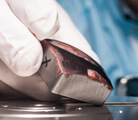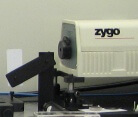Contact
DFM A/S
Kogle Allé 5
DK-2970 Hørsholm
Denmark
Tel: +45 7730 5800
E-mail: [email protected]
CVR/VAT#: DK29217939

LeNGTH CALIBRations
How long is a meter?
The metric system was introduced by law in Denmark 4th May 1907 and became effective the 1st April 1912. At that time the meter was defined by the distance between two marks on a platinum-iridium prototype (at 0 °C) kept at the BIPM in Paris.
Today, the meter is one of the seven base units of the SI system and is defined as the length of the path travelled by light in vacuum during a time interval of 1/299.792.458 of a second. The Danish primary standard of length is kept at and maintained by DFM.
On calibration within the field of length
DFM calibrates equipment and items for length measurements by using laser interferometry. This method utilizes the ability of coherent light waves to create interference patterns.
All length calibrations at DFM are traceable to DFM’s primary standards for length. DFM has three primary standards which consist of iodine-stabilized HeNe-lasers having a relative accuracy of about 2×10-11.
DFM offers a range of services within the field of length, summarized in the data sheet here.
Gauge Blocks
DFM calibrates gauge blocks under accreditation between 0.5 mm to 100 mm, traceable to the Danish primary standard, using interferometry. The gauge blocks for this service need to be made of steel, carbide or ceramics, and need to adhere to the requirements in ISO3650 (class 00 or K), or similar. The calibration is DANAK accredited (Accreditation No. 255).
The stated uncertainties below require that DFM calibrates at least 4 gauge blocks, that each of these has a nominal length of more than 3 mm, and that the total length of these 4 gauge blocks is no more than 100 mm.
Uncertainty of gauge block calibration - Absolute length
Gauge blocks in accordance with ISO3650, or similar.
| CLASS | MATERIAL | NOMINAL LENGTH | UNCERTAINTY |
| 00 or K | Steel, carbide, or ceramics | < 100 mm | 23 nm - 43 nm |
Uncertainty of gauge block calibration - Length difference
Gauge blocks from the same set, in accordance with ISO3650, or similar.
| CLASS | MATERIAL | NOMINAL LENGTH | UNCERTAINTY |
| 00 or K | Steel, carbide, or ceramics | < 100 mm | 15 nm |
Calibration of distance sensors and actuators
DFM calibrates different types of distance sensors, used for measuring length or distance, and of actuators, used for executing linear translations. These devices are often an essential part of the quality control on production lines, and for ensuring compliance with regulatory requirements.
The measurement range covers approx. 100 nm to 1 m, and the relative measurement uncertainty may reach 10-6. In most cases, however, the measurement uncertainty is limited by the characteristics of the device to calibrate.
The calibrations are traceable to the Danish primary standard of length.
Pricing
Please take a look at our price list, here.




